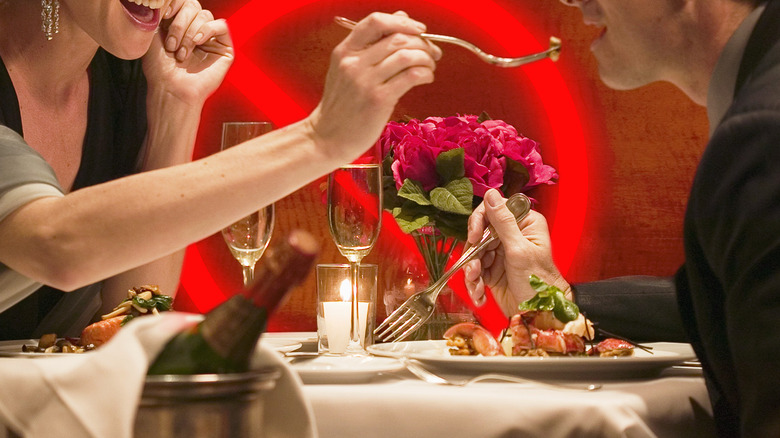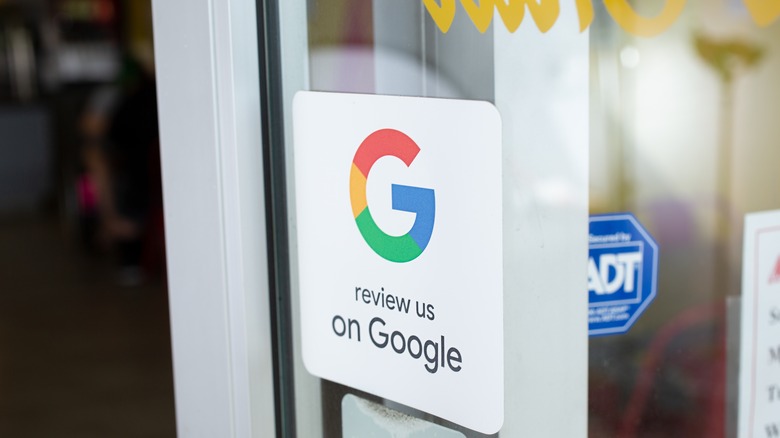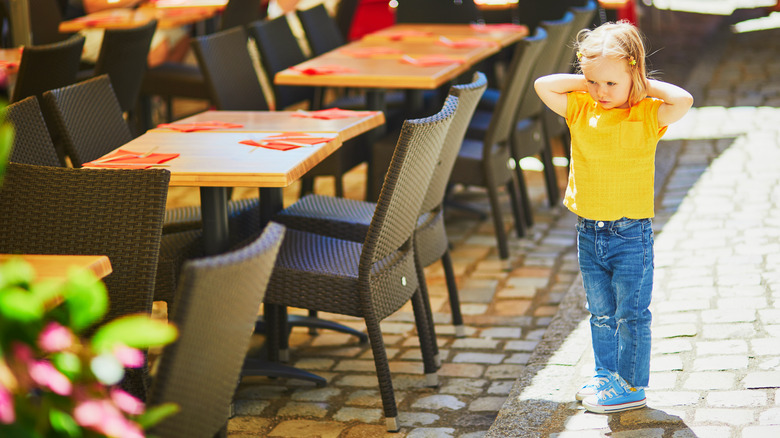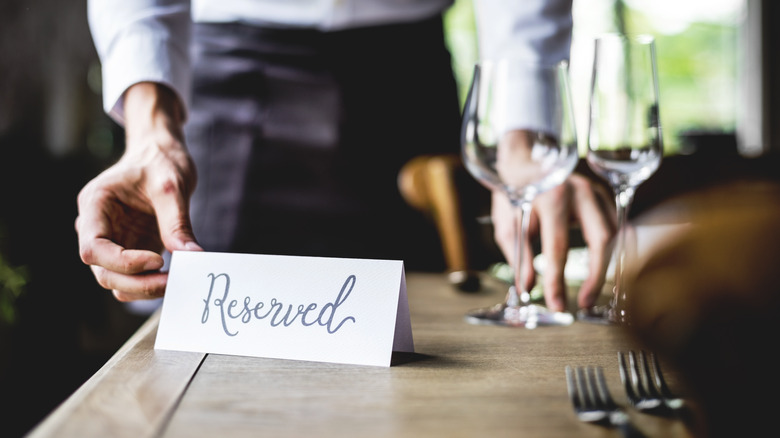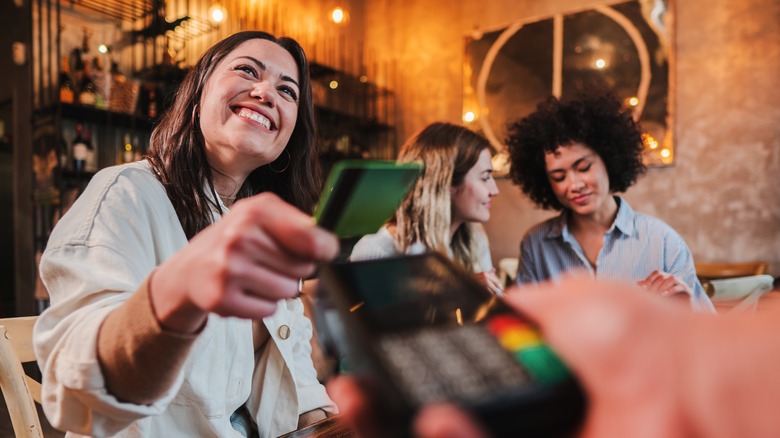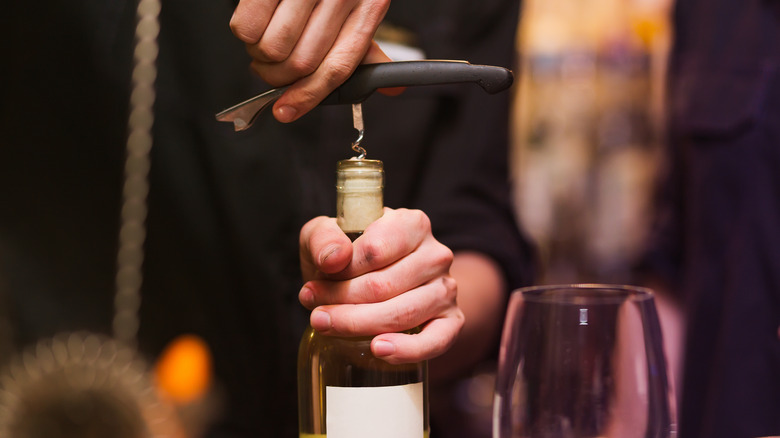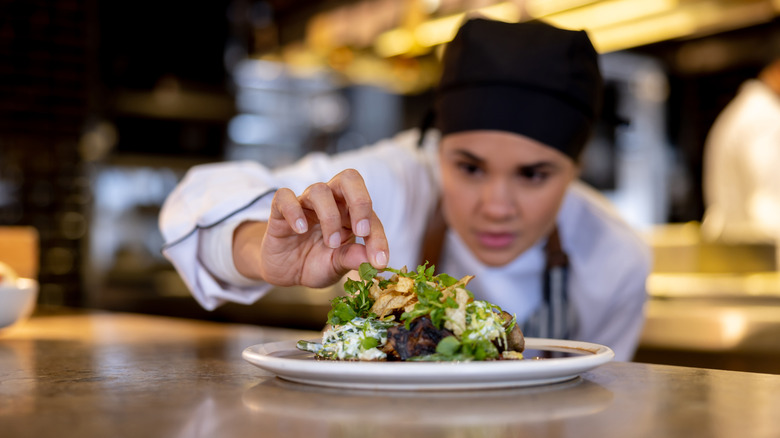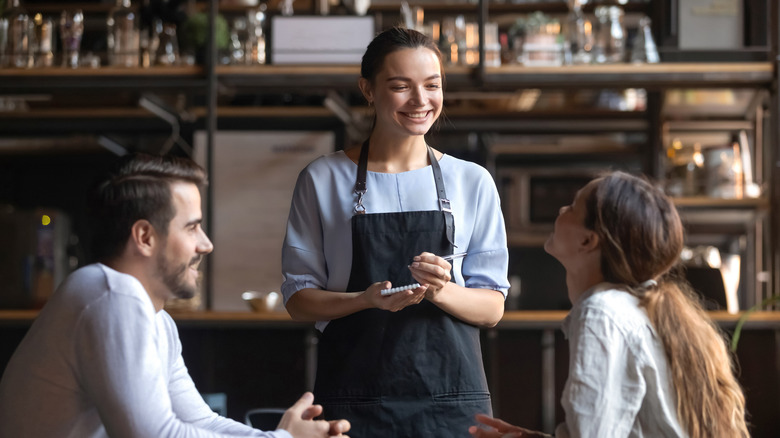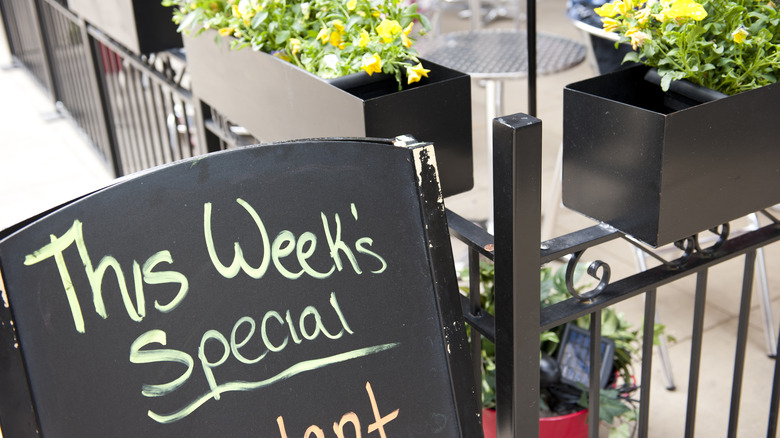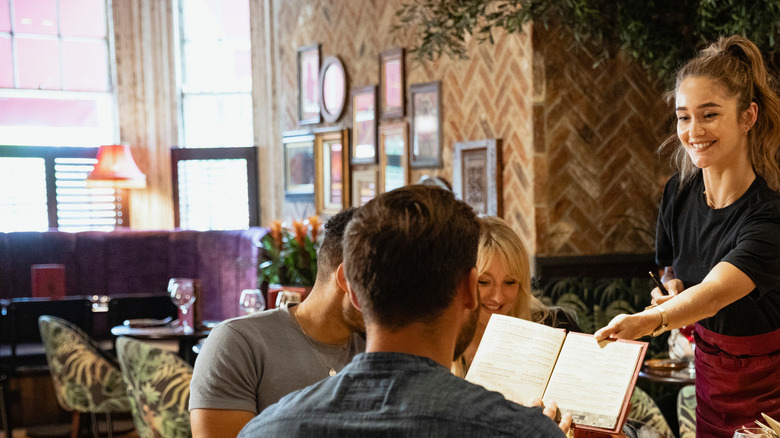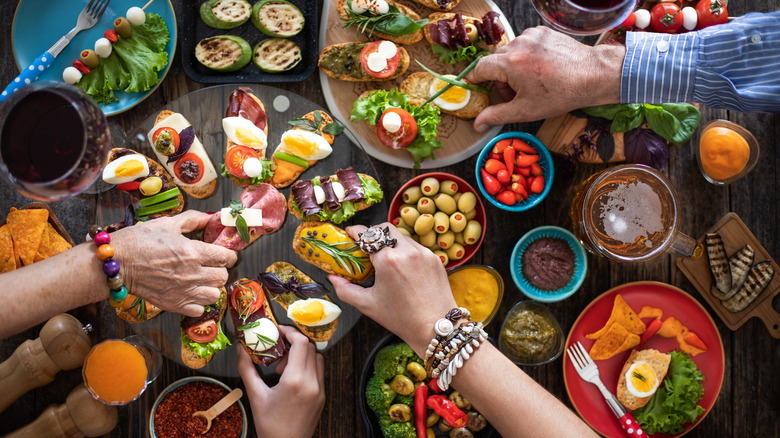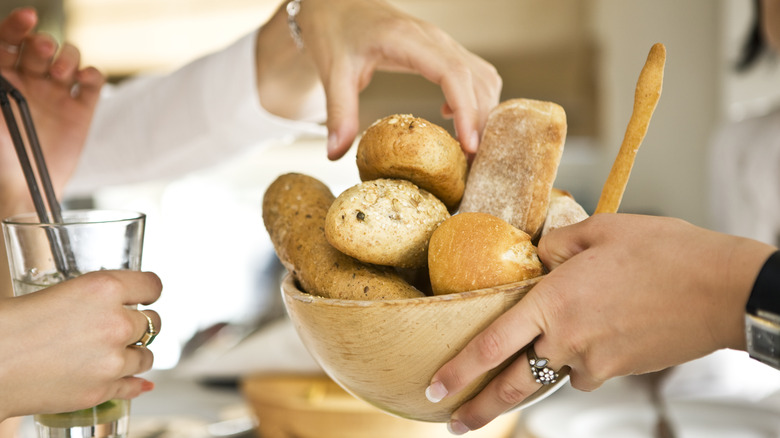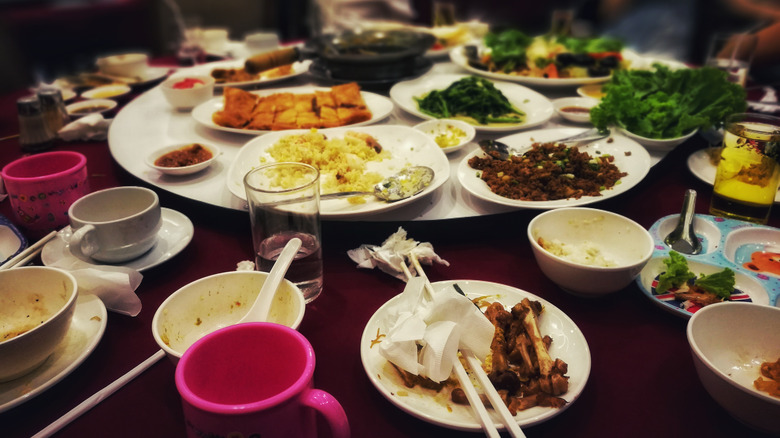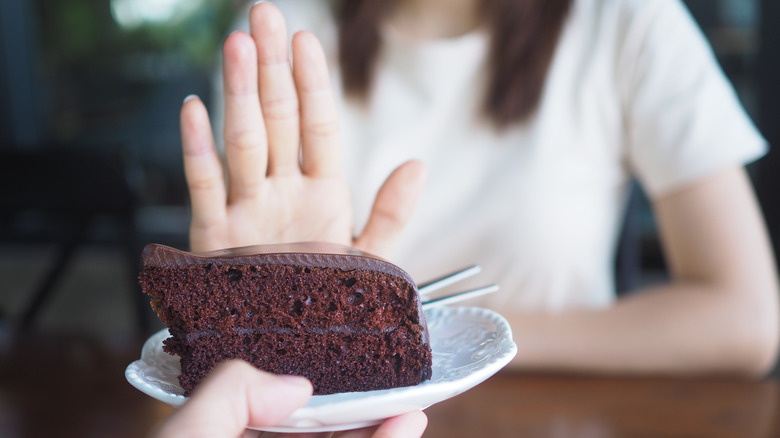Mistakes Everyone Makes When Dining Out
From a laidback lunch to a sophisticated postmodern plate in a decadent dining room, dining out can be a great experience for the mind and body. It's a feelgood way to indulge in new and favorite dishes that you don't have to make yourself and spend an enjoyable time with others. Delicious tastes can ignite your passion for life and adventure for culinary flavors. And while some restaurant dishes weigh heavily on a diet, others promise fresh ingredients that are good for you.
If all you're worried about is what to wear when eating out, you're not alone, as it's one of the bigger stresses. However, before you even make a reservation, you might want to make sure you're not making mistakes lots of people tend to make when dining out. Read on to find out the most common flubs, and how to avoid them to achieve a smoother dining experience.
Not properly researching the quality of a restaurant
Just because a restaurant looks cool, has a great-sounding menu, and is in a fabulous location doesn't mean it's going to deliver quality. The food isn't necessarily the be-all and end-all, but if it's terrible or the service is bad, it can ruin the whole experience. When booking a bistro you haven't dined at before, don't forget to research whether it's up to your dining-out standards.
These days, everybody reads online reviews; in fact, a cluster of positive writeups can be the bread and butter of a restaurant's success. But not everyone approaches online reviews with an appropriate level of scrutiny. Look out for bad reviews that seem to be more about personal taste or down to an unlucky experience. Give more serious consideration to dishes that are repeatedly given a thumbs down, as well as a thumbs-up, and note any stark hygiene or reservation issues that don't seem to be one-offs. No restaurant is perfect but choose wisely.
Not choosing the most suitable restaurant
Turning up at a restaurant with absolutely no atmosphere and more serving staff than diners can really dampen the dining-out experience. And there's nothing worse than scouring a gourmet menu for the most affordable entrée while under the judgmental gaze of a snooty waiter. Meanwhile, a restaurant that's popular with families and kids can really turn off loved-up couples celebrating a special anniversary. And what's worse than a group meal that's on the other side of town and will be tortuous to get to?
Dining out isn't just about the food. It's a big mistake to not consider the ambiance, location, budget, and occasion, too. For example, a conveyor belt sushi restaurant might not be the best idea for diners looking for a sedate, light lunch in peaceful surroundings. For a date, try selecting a few choices that are varied but meet the right criteria for a successful evening.
Not making a reservation
Do you remember the days when you could waltz into a restaurant on the spur of the moment for a light lunch or an extravagant dinner? In many places and eateries, times have changed, and reservations are a must. This is no doubt partly due to more reservation platforms and diner behavior. Reservations also increased after the pandemic, and of course, restaurants like reservations because they want to know how many covers they have and when they'll be there so they can maximize profits.
It's a mistake not to reserve a table when possible. For a group booking, it's much better to get diners together beforehand, rather than wait for everyone to show up individually. Tables are often reserved for a limited time, and waiting around for dining partners can eat into that. Of course, the main issue with not reserving a spot for your party is the potential for disappointment, along with disgruntled and potentially hangry would-be diners. If you grab a timeslot, you might also be able to select the table that you want, as well. If you know a restaurant and want to sit at a table with a great view or in a certain section, then you don't want to chance it. You might end up on a romantic date night at a table for two by the bathrooms or next to a noisy kitchen.
Not looking for dining deals
If you're heading out for a special night of fine dining, then you're probably not going to balk at a hefty bill once you've quaffed an espresso and a digestif. Gourmet grazing doesn't come cheap, and top restaurants often have waiting lists. However, in the glut of everyday eating-out experiences, there are deals to be had if you know where to look. It's a mistake when dining out to not check out two-for-one deals, discounts at certain times, drink offers, and also nights with specials at lower prices.
Restaurants are businesses, after all, and competition can be fierce. During low-traffic, off-peak times, dining establishments might use various apps and deals to lure in more customeres so they have a steadier stream of covers. With over 50,000 restaurants affiliated with it, OpenTable is a worldwide restaurant reservation platform that gives diners points that can then be converted to discounts. For straight-up deals, you can also look to Groupon. Restaurant.com reveals good offers close to a would-be-diner's location, as well as gift cards and prepaid certificates to make the most of the discount deals on offer.
Not considering the wine menu and BYO options
You might be advised which wines pair with which dishes by a sommelier at a high-end restaurant, or a head server may impart some recommendations from the wine list at a good eatery. Either way, it's always a good idea to take a look at the wine menu when booking a table, as long as you're keeping your budget in mind. While food may be reasonably priced, adding on a few bottles might pump up the final bill too much. Even if money doesn't happen to be as much of an issue, if you're a wine buff, you'll want to make sure that you're not let down by a lack of crisp whites or robust reds.
It's good to note that wines by the glass can actually work out to be a lot pricier than by the bottle, especially since there's often such a large markup on wine. Meanwhile, it could be a mistake to not check out whether there's a BYOB policy. If so, be sure to find out the corkage charge before booking. You might want to take a look at our recommendations for the best red wines and take a bottle with you the next time you dine out.
Not trying one dish first
There's a reason that restaurants often add fancy descriptions to their menus — obviously, doing so can make dishes sound more appealing. And the more appetizing they sound, the more likely you are to order them, especially if you're hungry. Who doesn't want a steak that's succulent or a burger that's described as a "must-try house special?" However, a great menu doesn't always equate to fantastic food.
You've probably had dining-out experiences where more than one member of your party ordered the same dish, only to find out they made a bad call. Ways of guarding against this include reading reviews and not ordering dishes that are off-piste, culinarily speaking. You could also try ordering just one dish to start with. If you're sharing dishes, then this means everyone can have a bite, too. Try a signature dish to test the skills of the chefs or the soup to get a basic measure of the ingredients and quality of the dishes on the menu.
Not asking servers for recommendations
As you discuss what to order with your dining companions, don't forget the invaluable knowledge of your server. Unless you've eaten at a restaurant before, it's not always easy to figure out which dishes are stunners, and which are a bit so-so. Deliciousness isn't the only factor to consider, either; portions are also worth considering, as are ingredients.
Rather than asking your server to make recommendations from the entire menu, it might be best to at least narrow down your choice to a few dishes. You might be more likely to get a more in-depth review of each one. Servers may have been encouraged to push highlighted dishes on the menu. However, if you've got a server who is easy to engage with, then it's a mistake not to get their lowdown on the menu highlights. You could be specific about what you're in the mood for, too. For example, you might want to know which entrée is the lightest, or which meat dish is the most succulent. In a good restaurant, servers should have sampled the dishes, or at least they should understand what they are, as well as noted how much diners tend to like them.
Not looking at the specials
It's no doubt the case that some restaurants create specials to shift ingredients they need to serve, or else they'll have to throw them away, and the idea that a special is really a garbage-saving ploy might deter some diners from going off-menu. However, this could be a mistake, as not every dish written up on a chalkboard is a last-ditch attempt to dish out certain foods from the kitchen. In fact, those specially created dishes could be culinary gems that are entirely worth ordering.
Chefs can use a specials board to showcase seasonal ingredients. A dish that's on a board for one day only could include freshly caught seafood that's literally the catch of the day. If they're departing the confines of the menu, an ambitious chef de partie might introduce an innovative plate or try out different flavors, cooking techniques, and ingredients. Look how the specials compare in terms of style, cuisine, and price to other appetizers and entrées on the menu. If a restaurant that specializes in not-too-high-end Italian fare, for example, is serving up an extortionately priced Japanese special, you might want to proceed with caution. Why not order at least one appetizing-sounding special and include some tried and tested dishes from the menu?
Not deciding on dishes when you arrive
When you've made a restaurant reservation online, it's tempting to scour menus and decide on your courses beforehand. That way, you can look forward to the dishes you're going to chow down on. This is especially appealing if you are dealing with a large party and you want to avoid any dithering when you sit down. However, efficient as this may sound, not deciding on dishes when you arrive is arguably a mistake, and one that a lot of people make when dining out.
Of course, if you want to order an elaborate dish that requires giving the kitchen a 24-hour notice, then ordering ahead might be unavoidable. However, in the main, there are plenty of reasons to only peruse a menu when you actually sit down at the restaurant table. Reading and choosing between delicious food is part of the dining experience and makes extra sense if you're going to be sharing what you order. Not planning beforehand means you can go with the flow and choose what you are actually hungry for in the moment. Being present allows you to take a look at specials that aren't listed online or have just been decided upon that day by the chef. You can also chat with your server and be swayed by a fantastic-looking plate of food you see passing by from the kitchen.
Not sharing dishes
Before stating why one of the many mistakes everyone makes when dining out is not sharing food, it has to be said that there's a strong counterargument that applies in some cases. If you're faced with a high-end menu in an upmarket bistro, then you may feel sharing a delicate — and possibly small — plate is a little pointless. An appetizer that's only good for a few bites isn't big enough to offer to anyone else, except perhaps if you're enjoying a romantic dinner. Then you might be more than willing to part with one of only three lobster ravioli. Otherwise, fuggedaboutit. Splitting a burger is, for many, a no-no, whereas an interesting vegetable dish might work.
Aside from traditional-style restaurants, many eateries have a multitude of sections on the menu. You might find snacks and nibbles, a specific sharing menu, or a list of big plates, small plates, hot bites, and more. With so much to try, sharing is the way to go, and means you can elevate the dining experience by tasting so many more dishes. It's also a great strategy for avoiding disappointment if you choose unwisely with an individual entrée. Also, this casual approach to dining is fun and interactive.
Not holding back on the bread
It's a rookie error, but filling up on bread before your appetizer arrives is one of the most obvious mistakes folks make when dining out. If the rolls are homemade and warm with a cool pat of butter, then it can take terrific willpower not to gollop down the doughy delights. Enjoying a breadbasket that's brought round by a server brimming with seeded rolls and fancy-looking breads is part of the restaurant experience, though. It's simply a matter of not letting bread spoil your appetite.
It's easy to binge, but your appetizer won't taste as good if you're not that hungry anymore. It's time for a bit of adulting. At some eateries, it might not be clear how long the bread has been hanging around, or whether it's been warmed up after being offered at another table. Maybe someone picked up a roll, thought better of it, and put it back. Is that enough to scale down your carb-fest? Or maybe it's put you off those pre-dinner gut-busters altogether. If you do reach for a roll, remember it's etiquette to butter individual bite-size pieces. That should slow you down, if nothing else.
Not ordering the right amount of food
Have you ever arrived at a restaurant super-hungry and ended up getting carried away with your order? It's a classic case of your eyes being greedier than your belly. While you do want to show up with an appetite, a totally empty stomach might lead to not ordering the right amount of food. And any dishwasher working in a hot and steamy kitchen knows that plates do tend to come back with leftovers because of this. If you don't want to leave with an embarrassing number of doggie bags, then check yourself by following practical steps.
Consider what type of food you're ordering as well as the quantity. A high-carb dish with a meaty filling, such as a steak and kidney pie, is going to satisfy your appetite quickly compared to a salad. Listen to what others in your party think if you're opting for a sharing menu, so you can follow a wider spectrum of ideas rather than what your stomach is telling you. And remember, less can be more. Stuffing your face with food is off-putting, and if you know the time from ordering to serving is short, what's the rush? Order a little and then add dishes as you go along. You might find you not only order less, but also ask for different dishes than you might have if you had been ordering everything all at once.
Not ordering the right dishes off of the menu
Just because you love certain foods, that doesn't necessarily mean they're what you should be ordering off a menu. This is, in fact, a common mistake that plenty of folks make when dining out. For example, you might prefer to make certain traditional pasta dishes at home how you like them, unless you know of an Italian eatery that makes a superb version. In other words, you might love your own rich and creamy spicy mac and cheese more than a restaurant's potentially drier version of the same dish.
Meanwhile, ordering chicken can be a bland choice since it's such a staple in many households. Look for dishes that capture the imagination as well as the appetite, show culinary know-how, and use quality ingredients. Seasonal dishes are worth exploring, while a restaurant with a long menu isn't likely to specialize in the freshest foods. You might want to avoid foods that are easy to make at home. A salad is simple to make when dining in, as are heartier meals such as steak and a creamy mushroom risotto. Give food-poisoning classics such as oysters a miss unless you're dining at a restaurant known for its seafood. And instead of dipping your mitts into a dish full of peanuts of ambiguous age and origin, you might prefer an aperitif at home with some spiced roasted almonds as pre-dinner snacks.
Not skipping dessert
If you think that dessert is the best part of eating out, then you're not going to like the idea that ordering dessert is a mistake. There is some logic behind the argument. For starters, a lot of dining establishments buy their desserts elsewhere, rather than make them in-house. Since there's generally not much profit in this course, a lot of restaurants simply don't focus on quality as much.
There are exceptions, which include bistros that boast about beautiful after-dinner sweetness made from scratch. If you're not feeling it, then you might want to make your way back home and dig a spoon into the homemade gooey brownie that you made earlier. However, we wouldn't say no to a slice of Big Ole Cheesecake at Logan's Roadhouse. Additionally, ordering a lavish dessert at the start of a meal could encourage diners to choose healthier appetizers and entrées. So, in a roundabout way, you can argue that ordering dessert is good for your diet.
